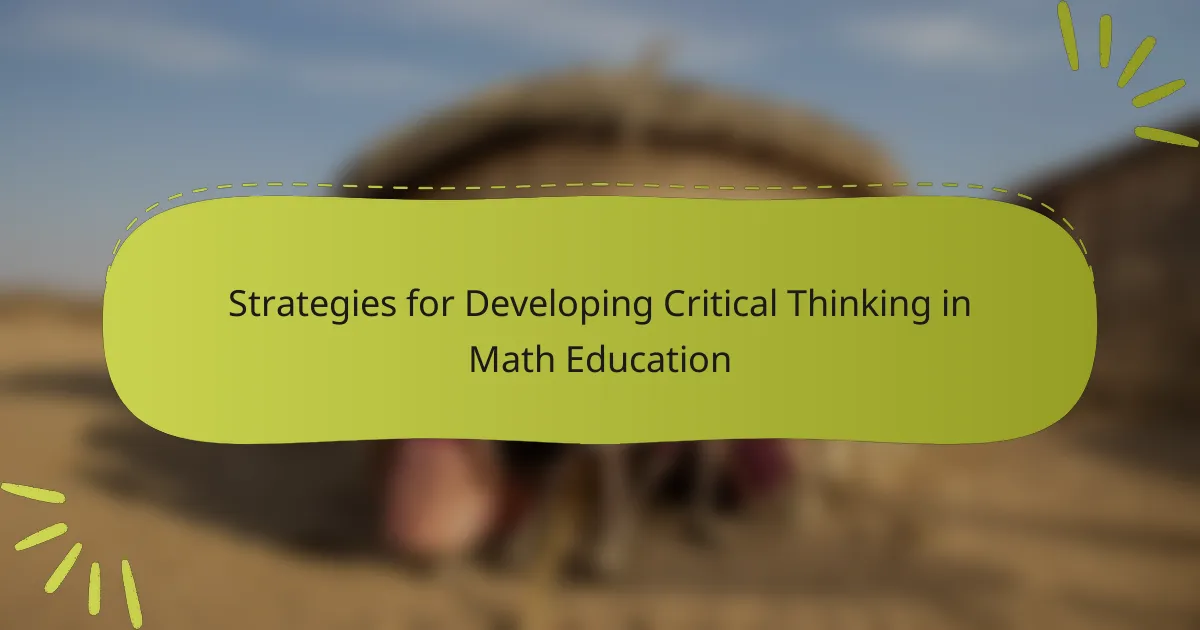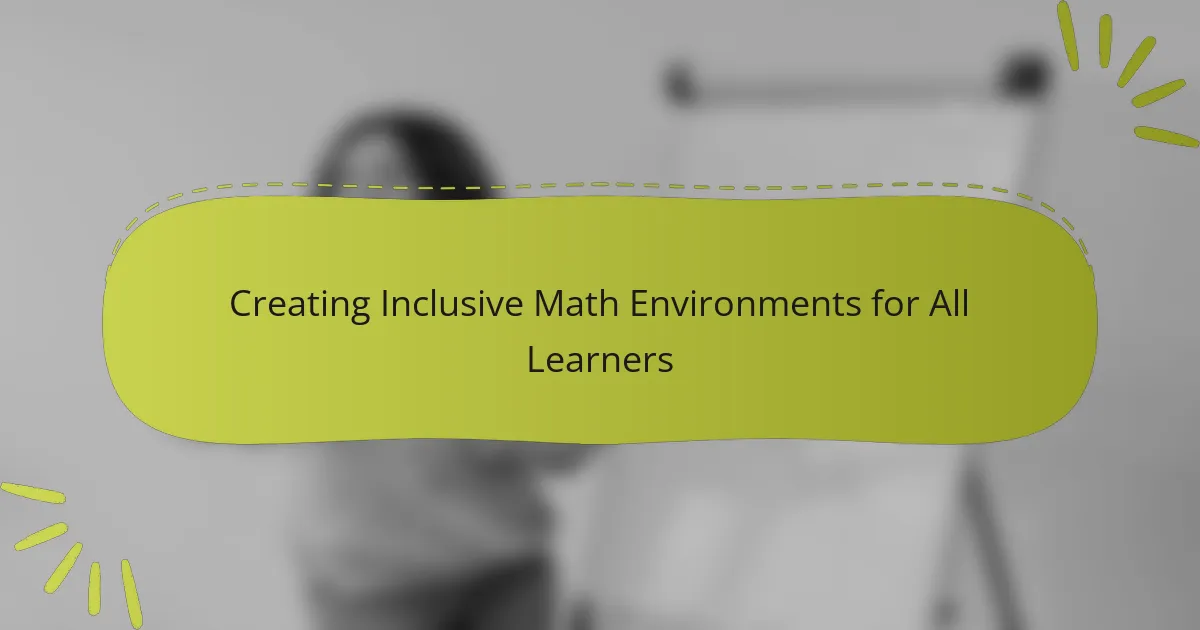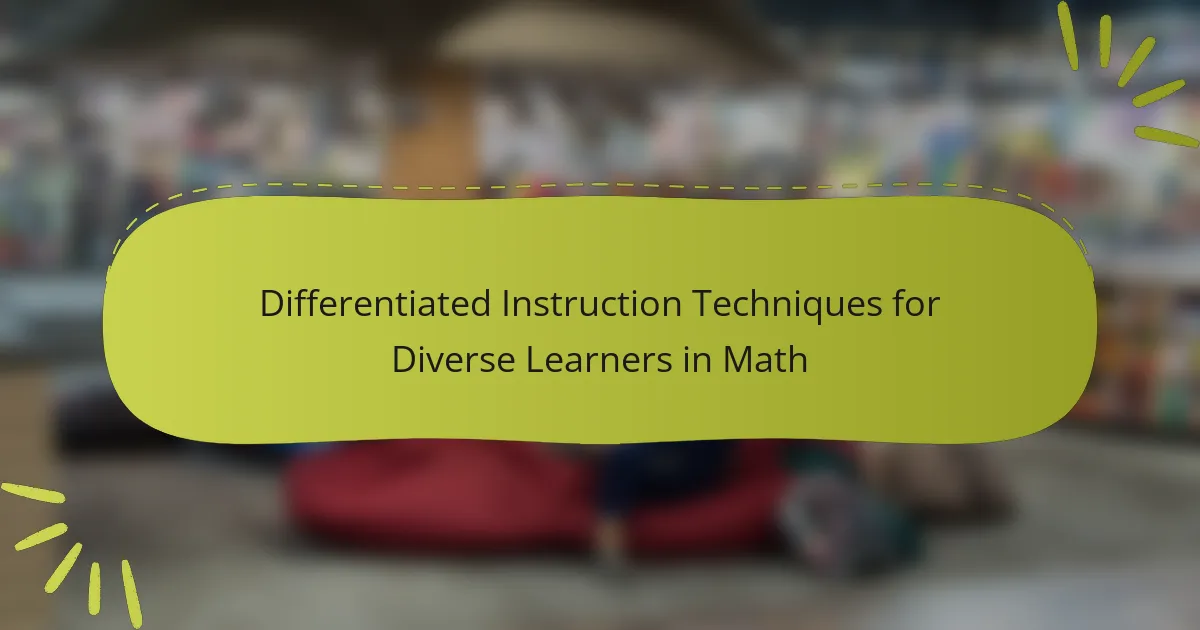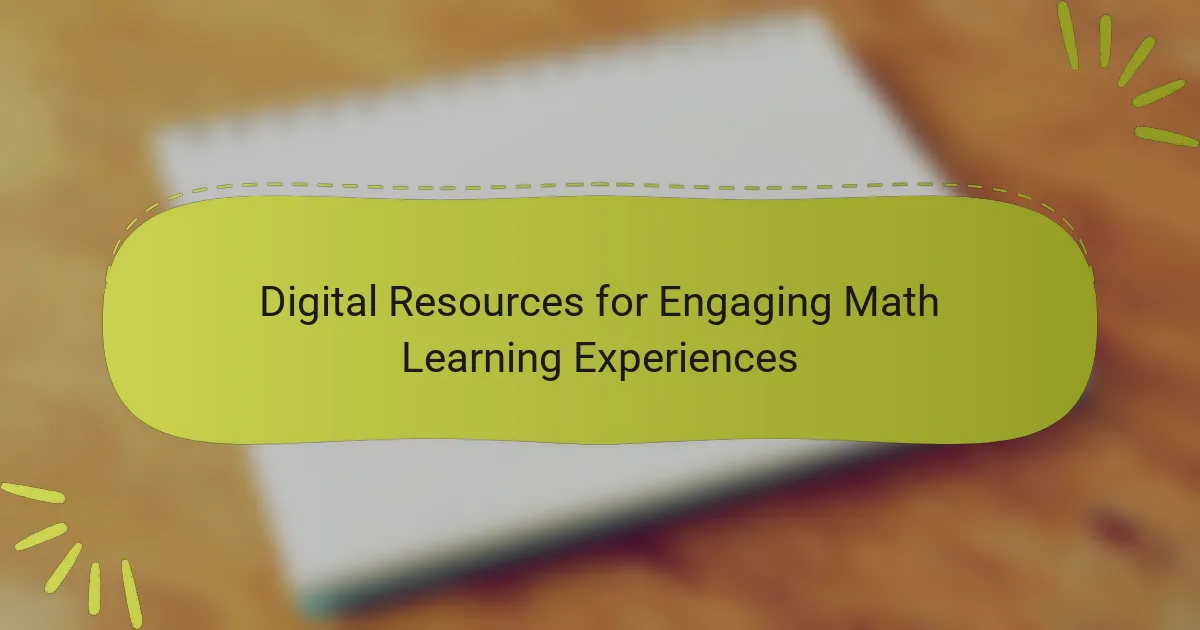Integrating technology into the math curriculum enhances mathematical understanding through the use of digital tools and resources. This approach includes software, online platforms, and interactive applications that increase student engagement and personalize learning experiences. Programs like Khan Academy offer tailored exercises based on individual progress, leading to improved test scores and problem-solving skills. Research supports the integration of technology as a means to foster critical thinking and collaboration among students, transforming traditional math instruction into a more dynamic and accessible experience. The National Education Technology Plan underscores the significance of this integration in modern education.
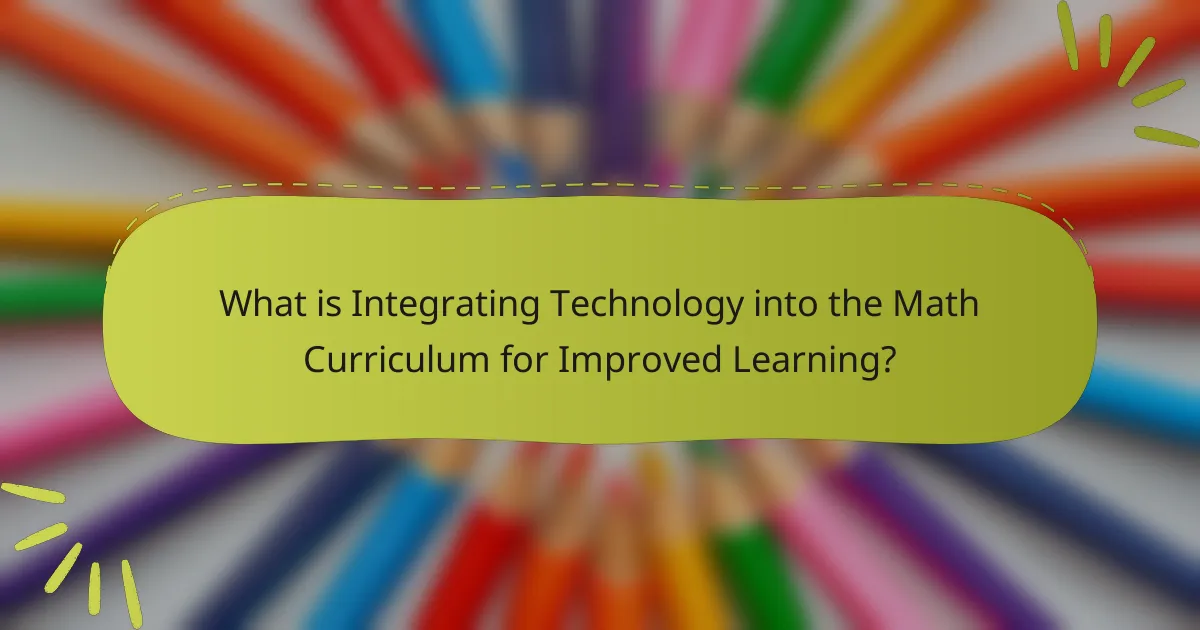
What is Integrating Technology into the Math Curriculum for Improved Learning?
Integrating technology into the math curriculum for improved learning involves the use of digital tools and resources to enhance mathematical understanding. This approach includes software, online platforms, and interactive applications that facilitate engagement. Research shows that technology can personalize learning experiences, catering to diverse student needs. For example, programs like Khan Academy provide tailored exercises based on individual progress. Studies indicate that students using technology in math education often demonstrate higher test scores and improved problem-solving skills. The National Education Technology Plan emphasizes the importance of technology in fostering critical thinking and collaboration among students. Thus, integrating technology effectively transforms traditional math instruction into a more dynamic and accessible learning experience.
How does technology enhance the math learning experience?
Technology enhances the math learning experience by providing interactive tools and resources. These tools include software applications, online platforms, and educational games. They engage students through visual and auditory learning methods. For example, interactive simulations allow students to visualize complex mathematical concepts. Research shows that students using technology achieve higher test scores. A study by the National Education Association found that technology integration can improve student performance by up to 30%. Additionally, technology facilitates personalized learning experiences. Adaptive learning programs adjust to individual student needs, promoting mastery of topics. Overall, technology makes math more accessible and enjoyable for learners.
What are the different types of technologies used in math education?
Different types of technologies used in math education include interactive software, online platforms, and digital tools. Interactive software, such as GeoGebra and Desmos, allows students to visualize mathematical concepts. Online platforms, like Khan Academy, provide instructional videos and practice exercises. Digital tools, including graphing calculators and math apps, support problem-solving and calculations. Additionally, learning management systems, such as Google Classroom, facilitate assignment distribution and communication. These technologies enhance engagement and promote understanding in math education. Studies show that integrating technology can lead to improved student performance and motivation in mathematics.
How do these technologies cater to different learning styles?
Technologies in the math curriculum cater to different learning styles by providing diverse instructional methods. Visual learners benefit from interactive simulations and graphical representations. Auditory learners gain from instructional videos and podcasts that explain concepts. Kinesthetic learners engage through hands-on activities using digital tools. These technologies accommodate individual preferences and enhance understanding. Research shows that personalized learning approaches improve student engagement and retention. A study by the Bill & Melinda Gates Foundation found that adaptive learning technologies significantly increase student achievement.
Why is it important to integrate technology into the math curriculum?
Integrating technology into the math curriculum is essential for enhancing student engagement and understanding. Technology provides interactive tools that make complex concepts more accessible. For instance, software like GeoGebra allows students to visualize mathematical relationships. This visualization aids in comprehension and retention of information. Furthermore, studies show that technology integration can improve problem-solving skills. According to a report by the National Education Technology Plan, effective technology use can lead to higher academic performance. In addition, technology fosters collaboration among students through online platforms. This collaborative learning environment encourages peer-to-peer interaction and support. Overall, integrating technology in math education prepares students for a tech-driven world.
What evidence supports the effectiveness of technology in math learning?
Technology enhances math learning effectiveness through various studies and data. Research shows that students using educational technology score higher on math assessments. A meta-analysis by Hattie (2017) indicates that technology integration has a significant effect size of 0.57 on student achievement. Additionally, a study by the National Education Association (NEA) found that technology in classrooms increases student engagement and motivation. Tools like interactive software and online platforms provide personalized learning experiences. These resources cater to diverse learning styles, improving overall comprehension. Evidence from the International Society for Technology in Education (ISTE) highlights that technology fosters collaboration and problem-solving skills in math.
How does technology prepare students for future careers?
Technology prepares students for future careers by equipping them with essential skills and knowledge. It enhances problem-solving abilities through interactive learning tools. Students gain proficiency in software that is widely used in various industries. For example, learning coding languages prepares them for tech-related jobs. Collaborative platforms foster teamwork and communication skills. These skills are critical in most modern workplaces. Moreover, technology provides access to real-world data for practical applications. This experience helps students understand industry standards and expectations. Overall, technology integration in education aligns learning with future career demands.
What challenges exist in integrating technology into the math curriculum?
Integrating technology into the math curriculum faces several challenges. One major challenge is the lack of adequate training for teachers. Many educators are not proficient in using technology effectively in their teaching. This can lead to ineffective implementation and underutilization of available tools.
Another challenge is the disparity in access to technology among students. Not all students have equal access to devices or reliable internet. This can create an uneven learning environment where some students benefit while others do not.
Additionally, there is often resistance to change from traditional teaching methods. Many educators and institutions are accustomed to conventional approaches and may be hesitant to adopt new technologies.
Lastly, the rapid pace of technological advancement can make it difficult to keep curricula updated. Educational institutions may struggle to integrate the latest tools and resources in a timely manner. These challenges must be addressed to successfully integrate technology into the math curriculum.
What are the common barriers teachers face when using technology?
Teachers commonly face barriers such as lack of training, insufficient resources, and resistance to change when using technology. Many educators report feeling unprepared to integrate technology effectively into their teaching. A study by the International Society for Technology in Education found that 70% of teachers cite inadequate professional development as a significant obstacle. Additionally, limited access to devices and reliable internet connectivity further complicates technology use in classrooms. These challenges can hinder the effective integration of technology into the math curriculum, impacting student learning outcomes.
How can schools overcome these challenges?
Schools can overcome challenges in integrating technology into the math curriculum by providing comprehensive teacher training. Effective training equips educators with the skills needed to utilize technology effectively. Additionally, schools should invest in reliable technological infrastructure. A robust infrastructure ensures that all students have access to necessary tools.
Furthermore, schools can foster collaboration among teachers to share best practices. Collaborative efforts can lead to innovative solutions and improved teaching strategies. Schools should also engage parents and the community in technology initiatives. Community support can enhance resources and provide additional learning opportunities.
Lastly, ongoing assessment of technology integration is crucial. Regular evaluations help identify areas for improvement and adapt strategies accordingly. These combined efforts can significantly enhance the integration of technology in math education.
How can educators effectively implement technology in math lessons?
Educators can effectively implement technology in math lessons by integrating interactive tools and resources. These include software applications, online platforms, and educational games designed for math learning. For example, programs like GeoGebra allow students to visualize mathematical concepts dynamically. Utilizing learning management systems can facilitate personalized learning paths, adapting to individual student needs. Additionally, incorporating virtual manipulatives can enhance understanding of abstract concepts. Research indicates that technology integration can lead to improved student engagement and achievement. A study by the U.S. Department of Education found that technology use in classrooms can increase student performance in math by 20%.
What strategies can teachers use to incorporate technology seamlessly?
Teachers can use various strategies to incorporate technology seamlessly into their lessons. One effective strategy is to integrate interactive tools such as educational apps and software that enhance student engagement. Research shows that using platforms like Kahoot or Quizizz can increase participation and motivation among students. Another strategy is to utilize online resources for collaborative projects, allowing students to work together using tools like Google Docs. This fosters teamwork and improves digital literacy. Additionally, teachers can implement blended learning models, combining traditional teaching with online components. This approach has been shown to personalize learning and accommodate different learning styles. Regular professional development also equips teachers with the skills to effectively use new technologies in their classrooms. According to a study by the International Society for Technology in Education, ongoing training significantly boosts teachers’ confidence in using technology. By applying these strategies, teachers can create a more dynamic and effective learning environment.
How can teachers assess the impact of technology on student learning?
Teachers can assess the impact of technology on student learning through various methods. They can utilize formative assessments to evaluate student understanding during lessons. Summative assessments can measure overall learning outcomes after technology integration. Observations of student engagement and participation provide qualitative data on the impact. Teachers can analyze student performance data from technology-based tools. Surveys and feedback from students can reveal their perceptions of technology’s effectiveness. A study by the U.S. Department of Education found that technology use can enhance student achievement when implemented effectively. These methods collectively provide a comprehensive view of technology’s impact on learning.
What are the best practices for integrating technology into math education?
The best practices for integrating technology into math education include using interactive tools, incorporating real-world applications, and providing personalized learning experiences. Interactive tools, such as graphing calculators and math software, enhance student engagement and understanding. Real-world applications of math concepts help students see the relevance of their learning. Personalized learning experiences, facilitated by adaptive learning technologies, cater to individual student needs and pace. Research shows that technology integration can improve student performance in math. A study by the U.S. Department of Education found that students using technology in math education scored higher on assessments compared to those who did not. These practices create a dynamic learning environment that fosters better understanding and retention of mathematical concepts.
How can collaboration among educators enhance technology integration?
Collaboration among educators enhances technology integration by fostering shared knowledge and resources. When educators work together, they can exchange effective teaching strategies that incorporate technology. This collaboration allows for the development of a cohesive technology plan tailored to the curriculum. It also promotes professional development opportunities focused on technology use in classrooms. Research shows that collaborative environments lead to increased confidence in using technology among educators. Additionally, teachers can create interdisciplinary projects that utilize technology, enriching student learning experiences. Studies indicate that collaborative efforts result in improved student engagement and achievement in subjects like math.
What resources are available for teachers to improve their tech skills?
Teachers can access various resources to improve their tech skills. Online platforms like Coursera and edX offer courses specifically for educators. Websites such as Tech & Learning provide articles and tutorials on the latest educational technologies. Professional development workshops often focus on tech integration in classrooms. Additionally, local school districts may offer training sessions. Educational technology conferences, like ISTE, present opportunities for hands-on learning. These resources help teachers stay updated on technology trends and tools.
What tips can educators follow for successful technology integration in math?
Educators can follow several tips for successful technology integration in math. First, they should select appropriate tools that align with learning objectives. Tools like interactive software or online platforms can enhance engagement. Second, educators must provide professional development for effective use of technology. Training increases teachers’ confidence and skills in using digital resources. Third, they should encourage student collaboration through technology. Collaborative tools foster communication and teamwork among students. Fourth, educators need to assess student progress using technology. Digital assessments can provide immediate feedback and data analysis. Finally, integrating real-world applications can enhance relevance. Connecting math concepts to real-life scenarios improves student understanding and interest.
Integrating technology into the math curriculum is a strategic approach that enhances mathematical understanding through digital tools and resources. This article explores how technology, including interactive software and online platforms, improves student engagement, personalizes learning experiences, and fosters collaboration. It discusses the various types of technologies used in math education, their impact on different learning styles, and the evidence supporting their effectiveness. Additionally, the article addresses challenges educators face in technology integration and offers best practices for successful implementation in math lessons.
